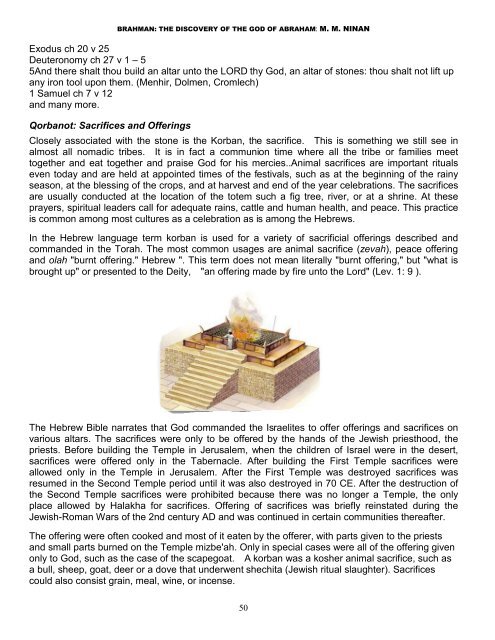Create successful ePaper yourself
Turn your PDF publications into a flip-book with our unique Google optimized e-Paper software.
BRAHMAN: THE DISCOVERY OF THE GOD OF ABRAHAM: M. M. NINAN<br />
Exodus ch 20 v 25<br />
Deuteronomy ch 27 v 1 – 5<br />
5And there shalt thou build an altar unto the LORD thy God, an altar of stones: thou shalt not lift up<br />
any iron tool upon them. (Menhir, Dolmen, Cromlech)<br />
1 Samuel ch 7 v 12<br />
and many more.<br />
Qorbanot: Sacrifices and Offerings<br />
Closely associated with the stone is the Korban, the sacrifice. This is something we still see in<br />
almost all nomadic tribes. It is in fact a communion time where all the tribe or families meet<br />
together and eat together and praise God for his mercies..Animal sacrifices are important rituals<br />
even today and are held at appointed times of the festivals, such as at the beginning of the rainy<br />
season, at the blessing of the crops, and at harvest and end of the year celebrations. The sacrifices<br />
are usually conducted at the location of the totem such a fig tree, river, or at a shrine. At these<br />
prayers, spiritual leaders call for adequate rains, cattle and human health, and peace. This practice<br />
is common among most cultures as a celebration as is among the Hebrews.<br />
In the Hebrew language term korban is used for a variety of sacrificial offerings described and<br />
commanded in the Torah. The most common usages are animal sacrifice (zevah), peace offering<br />
and olah "burnt offering." Hebrew ". This term does not mean literally "burnt offering," but "what is<br />
brought up" or presented to the Deity, "an offering made by fire unto the Lord" (Lev. 1: 9 ).<br />
The Hebrew Bible narrates that God commanded the Israelites to offer offerings and sacrifices on<br />
various altars. The sacrifices were only to be offered by the hands of the Jewish priesthood, the<br />
priests. Before building the Temple in Jerusalem, when the children of Israel were in the desert,<br />
sacrifices were offered only in the Tabernacle. After building the First Temple sacrifices were<br />
allowed only in the Temple in Jerusalem. After the First Temple was destroyed sacrifices was<br />
resumed in the Second Temple period until it was also destroyed in 70 CE. After the destruction of<br />
the Second Temple sacrifices were prohibited because there was no longer a Temple, the only<br />
place allowed by Halakha for sacrifices. Offering of sacrifices was briefly reinstated during the<br />
Jewish-Roman Wars of the 2nd century AD and was continued in certain communities thereafter.<br />
The offering were often cooked and most of it eaten by the offerer, with parts given to the priests<br />
and small parts burned on the Temple mizbe'ah. Only in special cases were all of the offering given<br />
only to God, such as the case of the scapegoat. A korban was a kosher animal sacrifice, such as<br />
a bull, sheep, goat, deer or a dove that underwent shechita (Jewish ritual slaughter). Sacrifices<br />
could also consist grain, meal, wine, or incense.<br />
50


















